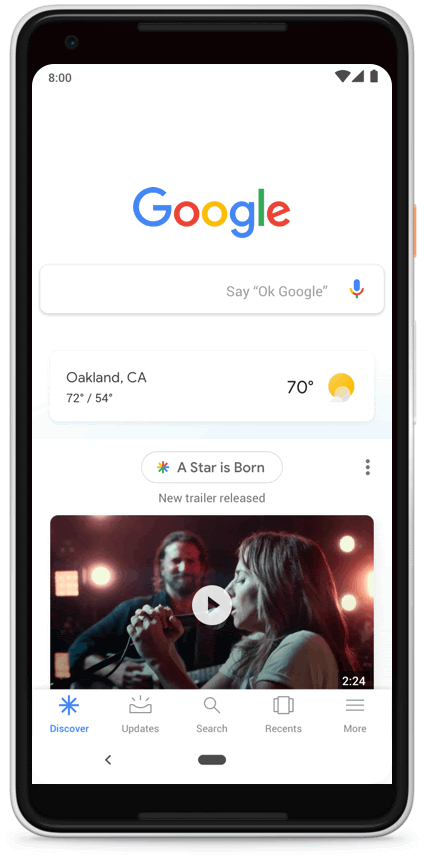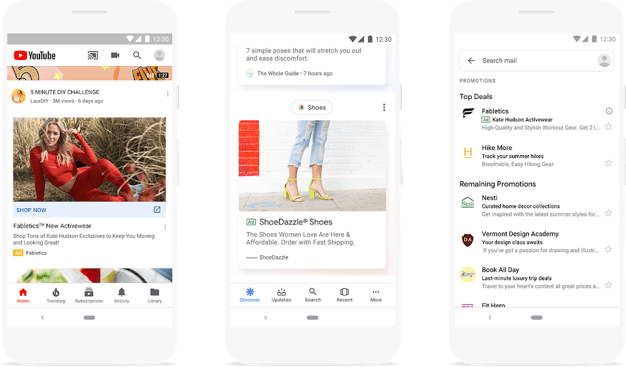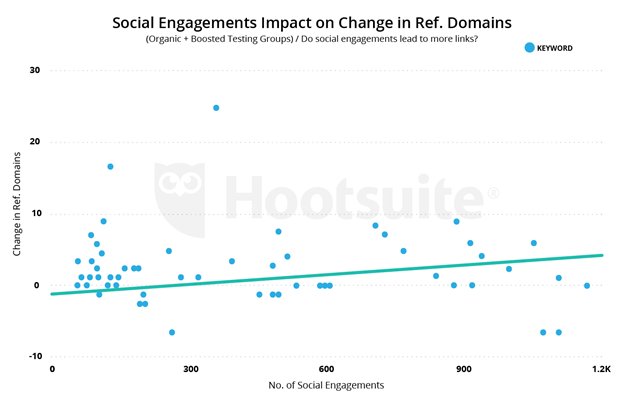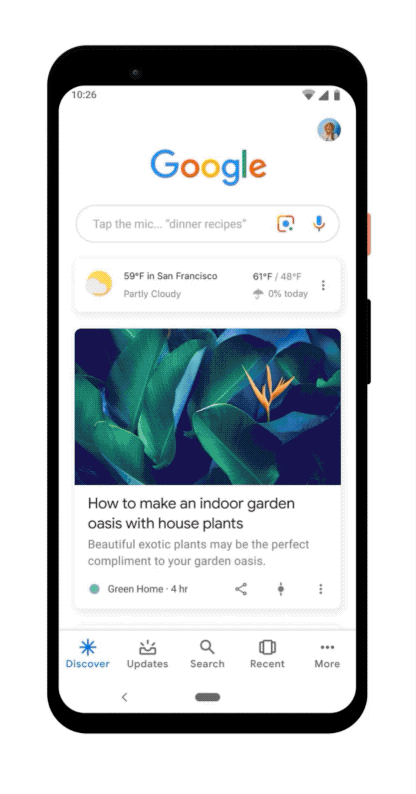What is Google Discover?
Google Discover is a feature of the Google mobile App, which serves content from around the web in a feed experience based on your personal interests, browsing history, and trending topics in your area.
 (Google Discover feed. Image: The Keyword)
(Google Discover feed. Image: The Keyword)
Google Discover is accessible via a star icon on the Google app or a version of it in the default homepage of your Chrome mobile browser.
Google Discover was first introduced in late 2016 under the name “Google Feed.” It was originally designed to keep users up-to-date with news in their fields of interest. It has undergone a couple of facelifts since then, and today it also contains evergreen content, product pages, and even restaurant recommendation cards.
Current State: Discovery
We’re still in the discovery stage of Google Discover: We don’t know much about Discover, and even less is known about how you can have your content to be featured on it. But no worries! We have gathered some facts and figures to help you understand what you are up against, and a few tips to hopefully get your first article featured on Google Discover.
In the September 2018 blog post that announced the rebrand of Google Discover, the search engine also revealed that the Discover Feed has more than 800 million monthly active users.
At the time, they also took the opportunity to inform the search community about some new additional features:
- New topic headers: These explain why you are seeing what you’re seeing. However, these were removed shortly after (you can still see the topic of each article by clicking the 3 dots menu).
- Evergreen content: Back when Google initiated the feed, the aim was to supply you with fresh content. The search product marketing team announced that you would now be able to see articles “that aren’t new to the web, but are new to you.” Judging from a small test we conducted, a large percentage of the content dates 48 hours back.
- See more/less button: This was designed to help you decide what you want to see on your feed. (The AI mechanism here doesn’t seem to be a fast learner though...)
- Multilingual support: Discover content in your preferred language for each area of interest.
- Mobile devices: The feed will be presented also on the Google homepage on all mobile browsers.
Later on, in 2019, Google officially announced that Discovery Ads would be released to all advertisers later that year. This meant that Google aimed to monetize Discover (as well as the YouTube home feed and Gmail) and “reach people across Google properties in the moments when they’re open to discovering your products and services.”

(Google Discovery Ads appear on YouTube, Discover, and Gmail.)
We know that with ads comes great responsibility — and potentially more investment in the product.
Is Google Discover Important for Publishers?
If you are in the business of publishing content, the short answer is: yes! Even ecommerce sites have enjoyed traffic to product pages courtesy of Google Discover.
Google Discovery isn't only for the news sites! This is a screenshot about an e-commerce site and the "discovered" pages are products!#google #ecommerce #seo #gsc pic.twitter.com/P22xYDb5lI
— Merlinox 🏃🏻🇮🇹 (@merlinox) August 8, 2019
It was in June 2019 that Daily Mail SEO director Jesus Mendez reported in the Google Webmasters forum that the Daily Mail site saw their Discover feed traffic drop by 90% after Google’s June algorithm update. One can only imagine that this was quite a blow for the publisher who, in 2012, was recognized as the most visited newspaper website in the world.
If you have Google Search Console enabled for your site, you should check how many of your articles have been featured in the Discover feed and how many clicks those articles have generated. Here are two possible scenarios:
- You have many articles published and you generate tons of traffic from it. Congrats, you are AWESOME!
- You have little to no content published on the Discover feed. In this case, read on to learn how to generate traffic on Discover!
How to Optimize for Google Discover
Optimizing is a controversial word when it comes to SEO — and for the right reasons. You can’t really optimize against everything. A good example of this is optimizing for BERT or SMITH … the last time some in the SEO community wrote about optimizing for an algorithm, they were seriously shouted down for it.
So, let’s just settle for a few tips that could help your content (if, and only if, it’s already great content) to appear on the Google Discover Feed.
#1. Conduct Interest Research
Like any other SEO campaign, optimizing for Google Discover begins with keyword research. There is a slight difference though — Google Discover is an interest-based feed. So the best way to tackle this would be to conduct interest research as well.
How to conduct interest research?
There are four sources for conducting interest research, and depending on your niche, some may be more valuable than others:
- Google Analytics Audience > Interests > In-Market Segments/Affinity Audiences/Other Categories: Depending on your industry, you will find these three reports incredibly valuable. The main challenge here will be separating the wheat from the chaff. But once you have filtered out all irrelevant information, you will be left with genuine interests to target.
- Facebook’s Audience Insights: The interests that you will find here are not identical to the ones found on Google, but if you are looking to expand your interests base, this is a nice go-to tool.
- Your own Google Discover interest page: Click the three vertical dots menu in one of the articles and click the “Manage interests” section: you will be able to see which interests Google believes you are interested in, or some interests that you have decided to +follow. Try this help page if you haven’t been able to find your interests.
- Manually search for interests: This is a very important method, and should be the last step in your interest research.
Step 1: Type the interest into your Google app search bar. (Important! Do not use your Chrome address bar; this will yield different results.)
Step 2: Now search for the +follow sign next to the searched interest. If you found one, that’s a good sign. Most of the content in Discover is driven from these types of interests.
Step 3: You should treat the interests that can be followed the same way you would treat keywords derived from keyword-research in the process of content creation and optimization.
#2. Content & On-Page Optimization
Once you have all the interests mapped out, you should use them in the same manner you would apply keywords when you create new content. Some differences do apply here, such as:
Titles: As opposed to search, the titles featured in Google Discover are usually the article titles themselves (your <h1> in most cases). The optimal length to aim for should be less than 104 characters. (Make it 100 to be on the safe side.)
#3. Leverage Your Most Engaged Readers
Encourage your most valuable readers to +follow your domain of expertise in Google search. The reason is that Google serves Discover suggestions based on:
- User interactions with Google, and
- What’s trending in the user area
This means that when your site visitors use the +follow on certain interests that you publish, and they have your site in their history, Google gets a vote of trust that your engaged readers are interested in the subject of X. Hence, it needs to serve more content about ‘X’ to your users.
Then, more content from your site will be published on Discover and, more importantly, it will be published to “Lookalike Audiences.” So it’s a win-win situation!
#4. Implement Structured Data
You probably hear this a lot: “Structured data is so important!” … but this declaration normally never comes with a handbook that lists what type of schema you should implement on your site to get more traction.
In the case of Google Discover, the best (and probably only) suggestion we can make is to add the following:
Article / NewsArticle / BlogPost: If you don’t have this implemented yet, well, now’s the time! If you are a publisher of any sort, this should be a top priority for you.
How much does Google actually use this markup, you might ask? Well, if you are CNN, I wouldn't worry about Google figuring out you are in the news business … but just in case your site isn’t in the caliber of CNN, adding structured data won’t hurt and can only benefit you!
Take note though that Google does take manual actions against structured data abusers. So if you are not a news site, DO NOT use the NewsArticle schema.
#5. Use High-Quality Hero Images
In their debut post about optimizing for Google Discover, Google says:
Content is automatically eligible to appear in Discover if it is indexed by Google and meets Discover's content policies. No special tags or structured data are required. Please note that being eligible to appear in Discover is not a guarantee of appearing.”
The Search Central blog then offers six considerations to increase your likelihood of appearing in Discover. The real tip here is to use large, high-quality images that are at least 1,200 px wide — and avoid using your logo as the image of choice.
#6. Gain Social Trust Votes
There is no direct evidence to link SEO and social engagements. Matt Cutts addressed this issue back in 2014 in a YouTube video.
I am not going to claim that social signals play a role in the ranking process, but this doesn’t mean that social signals cannot indirectly impact rankings, as suggested in this research by Hootsuite.
TL;DR: Articles that were boosted on Twitter saw 22% increase in search visibility vs. articles that were not.
Why? One of the explanations suggested is that the boosted articles acquired more links, which in turn affected their rankings. They indeed found a positive correlation between the number of referring domains and the number of social engagements.
 (Image Source: Hootsuite)
(Image Source: Hootsuite)
#7. Amplify Your Strategic Content
So, we know that social engagements and rankings have a positive correlation and that boosting content gets your content more social engagement and in turn helps you earn more backlinks.
Amplifying your content using native advertising helps you send more engaged traffic to your site, and even though it’s not a ranking factor, it can help you get more exposure in the Discover feed.
As mentioned earlier, Google shows content on the Discover feed based on user interactions, which means that your site visitors who engage well with your content will ultimately be served more of your site’s content via Discover feed.
#8. Implement AMP
Despite the resentment towards Google AMP in large parts of the SEO community, we can’t stress enough how important this is for appearing in the Discover feed. Most of the articles there have AMP. Back in 2017, it was reported that 70% of articles published in Google News were AMP pages.
The exact same applies to Google Discover (maybe even more so, given that Discover, like AMP, is mobile only). You don’t need statistical research to see the prominence of AMP in the feed; you can simply count the number of AMP vs non-AMP cards on your feed. My guess is you’ll be at around 60% in favor of AMP.
Be sure you add Article structured data to your AMP page. Google officially indicates that:
AMP pages that have structured data can appear in a carousel of stories in search results. Without structured data, AMP pages may only appear as standard blue links in Google Search results.”
#9. Create Web Stories
Discover is Google's attempt to challenge the social platform feed experience, but no feed is complete without stories.
Web stories, formerly known as AMP stories, were introduced back in 2018, but it seems they have shifted a gear in the second half of 2020. Back in October, Google announced web stories will become a part of Discover.
Web stories are not yet widely adopted by many publishers, so they can potentially give you a competitive edge when it comes to Discover.
When you enable web stories on Google, you then give them the chance to appear across Google Search, Google Discover, and Google Images. This Google’s answer to the “story plague” that has stormed our shores, but in a bit of a more Google-y way.
 (Image Source: Google Search Central)
(Image Source: Google Search Central)
Conclusion
There you have it! Nine ways to optimize for Google Discover and leverage the feature to pull more traffic to your site, from research to implementation.
Here’s the list again, with some bonuses included:
- Conduct Interest Research
- Content & On-Page Optimization (Bonus: Content Fusion is a powerful content analysis and optimization tool — try it free!)
- Leverage Your Most Engaged Readers
- Implement Structured Data (Bonus: Use the free Schema Builder to build and deploy structured data)
- Use High-Quality Hero Images
- Gain Social Trust Votes
- Amplify Your Strategic Content
- Implement AMP
- Create Web Stories







Comments
Currently, there are no comments. Be the first to post one!